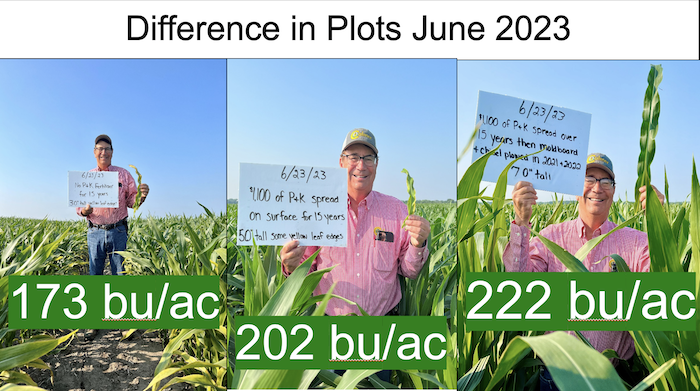In the last several years, vertical stratification in no-till fields has turned into a heated debate, thanks to No-Till Farmer Living Legend and No-Till Innovator of the Year Marion Calmer and what he is — and isn’t — doing to one of his long-term no-till fields.
Calmer, the founder of Calmer Corn Heads who farms in Alpha, Ill., introduced his on-farm research into vertical stratification at the 2022 National No-Tillage Conference. At the 2023 conference, he proceeded to shock a number of no-tillers with his decision to moldboard plow part of a no-till field in an effort to fix a vertical stratification problem — a problem that many have argued he could have fixed without the plow.
Signs of Stratification
Calmer first suspected that he had a stratification problem in 2017 when he saw purple leaves in his corn crop, a sign of a phosphorus (P) deficiency, even though his soil tests indicated he had adequate levels. As a longtime independent on-farm researcher, Calmer doesn’t accept money to conduct research, instead seeking his own projects and reporting the results as he sees them.
The stratification issue led him to sample the soil at an inch-by-inch depth, and he discovered that P and potassium (K) were stratified. The highest nutrient concentrations were at the soil surface, and the lowest were 8 inches deep.
To find out if he could move the high nutrient concentrations down to where the crop roots would be, Calmer moldboard plowed a strip 60 feet wide and 1,000 feet long in one of his long-term no-till fields. This is equivalent to about 1.4 acres. Prior to plowing, 42% of his K was in the top 2 inches and 16% was 6-8 inches deep. After moldboard plowing, his soil test results from that strip took more of a hexagon shape, with 45% of his K at the 3-6 inch depth.
2022 soybean yields where he tilled ended up at 77 bushels per acre, 9 bushels higher than the no-till soybeans. In 2023, Calmer says corn planted into the conventionally tilled strip yielded 222 bushels vs. 202 in the long-term no-till — a 20-bushel difference in a drought year.

On June 23, 2023, Marion Calmer compared the size of corn plants in three different plots on his Alpha, Ill., farm: a no-till plot with no phosphorus (P) and potassium (K) added for 15 years (L), a no-till plot with $1,100 of P and K spread on the surface for 15 years (center) and a strip of ground that was moldboard and chisel plowed for 2 years after 15 years of no-till and $1,100 of surface-applied P and K (R).
“That’s pretty tough for me to swallow because that’s $135 per acre,” Calmer said of his 2022 yield. “On 1,000 acres, that’s $135,000 that I left on the table last year because my P and K are stratified on the surface.
Calmer says his data shows surface stratification does occur naturally, but he believes all no-tillers are suffering from stratification.
“In my national study, I've been getting data back from people who no-till and people who do tillage,” Calmer says. “Everybody else who no-tills has a lot of fertilizer on the top but depleted down in the root zone. Even with a field cultivator, the minimum-till people aren't very successful at mixing it down into the profile.”
Calmer is now continuing the experiment in 2024 with plans to strip-till soybeans between his 2023 corn rows. Banding nutrients, in Calmer’s opinion, seems like the solution to his stratification problem.
What about Cover Crops?
After hearing Calmer’s presentations, many no-tillers have a different stratification solution for Calmer to try: cover crops.
Calmer has talked about this experiment at the National No-Tillage Conference three times, and every time he gets the question, “Have you tried cover crops?”
In 2022, Calmer said he learned at the conference that cover crops could be part of the solution to his stratification problem and was “about to introduce that to find out.”
“Does everybody have a stratification problem? That I do not know,” Calmer said. “I heard the comments about how no-till by itself is kind of a struggle and no-till with cover crops makes it a better system. Is cover crops the answer to keeping my nutrients from stratifying in the soil profile? But then again, how long is it going to take for cover crops to reverse 20-30-years of stratification?”
In 2023, Calmer said he planned to travel to the late No-Till Legend David Brandt’s farm and other farms to learn about covers.
“I don't have any cover crops in between my cash crop, but I certainly need to,” Calmer told a no-tiller who asked about cover cropping in 2023. “But I'm in the inventing business of corn harvesting equipment, and we are swamped, but still no reason that I shouldn't get the cover crops.”
Calmer said he has someone coming to help him put in covers for the 2024 season, recalling a straightforward comment from Brandt at the 2023 National No-Tillage Conference.
“Dave said, with no filters, ‘Marion, I just don't have stratification,’” Calmer said. “We can all hope that cover crops will reduce this problem. I don't know if it'll make it go away.”
At the 2024 conference, at least two attendees talked to me about vertical stratification — and they didn’t have good things to say about how much attention the topic is getting. One told me John Grove at the University of Kentucky did research proving vertical stratification is no big deal and no-tillers shouldn’t be overly concerned about it. Another said he was still wondering why Calmer hadn’t tried cover crops, despite being asked about them every year.
About a month after the National No-Tillage Conference, I attended the Soil Health Expo in Juneau, Wis., put on by the Dodge County Farmers for Healthy Soil and Water, and vertical stratification again took the stage.
“It’s bullshit,” Blake Vince, a no-tiller and Nuffield Scholar from Ontario, told a farmer who asked about vertical stratification. “I'm very disappointed that it was put into print.”
Vince said he and Calmer (although he didn’t mention Calmer by name) had visited each other’s farms. On Calmer’s ground, Vince noticed “beautiful black soil” but no earthworm activity.
“Now conversely, when that same gentleman stepped on my soil in southwest Ontario, the first words out of his mouth when he made 20 steps out in the field were, ‘Wow, you have a tremendous amount of earthworm activity,’” Vince said.
That’s thanks to cover crops, according to Vince, crediting them for providing a beneficial environment for earthworms, soil microbes and more to cycle nutrients and prevent stratification.
“I am not saying it can't happen, but I believe that part of the problem is the methodology, and he's not taking it full circle,” Vince said. “He's blaming the principle of no-till farming and saying no-till is the villain. You need to have the integration of living roots in conjunction with the mechanization of no-till.”
Fixing Soils
Vince and I talked after his presentation, and he told me he’s concerned about no-tillers turning back to tillage, instead of cover crops, as a result of all the buzz around vertical stratification.
Jim Hoorman, a No-Till Innovator and soil health consultant, shared his own take on Calmer’s study in a recent article for Ohio’s Country Journal. Hoorman says Calmer’s field, which had been in a corn-soybean rotation for years, only had live roots in the ground for about a third of each year. Live, fine roots exude root exudates that promote good soil structure; allow water, nutrients and gasses to move deeper into the soil profile; absorb soluble nutrients; and improve compaction, according to Hoorman.
“Long-term no-till plus cover crops mimic virgin soils,” Hoorman writes. “It may take 3-7 years to fix the poor soil structure and compaction problems from previous tillage passes, but over time, it is a more permanent solution.”
Hoorman pointed out that fellow No-Till Innovator Mike Starkey, who farms in Brownsburg, Ind., did the same 1-inch incremental study on two of his long-term no-tilled and cover cropped fields.
“His soils are acting like a sponge, and he did not find any stratification,” Hoorman writes. “In a 7-year study on water quality, his farm is hardly losing any nutrients, compared to conventional fields nearby which are losing both soil nutrients and soil sediment.”
If you are having trouble viewing the poll on your device, click here.
If Calmer is going to keep tilling and not using cover crops, Vince suggested that he do a 5-year experiment tracking yields in conventional tillage vs. no-till. Vince predicts now that Calmer has burned up all the carbon in the tilled strip, conventional yields will start to decline. Even better, in the eyes of many no-tillers, would be if Calmer starts comparing no-till with covers to straight no-till, eliminating the tillage pass altogether.
Marion, it seems as though the no-till community is issuing you a challenge. Devoted no-till and cover croppers want to see what happens if you give covers a chance.
Related Content
Placing Soil Stratification Under a Microscope (Part 1)
How Much Do Stratified Soils Cost in Dollars & Bushels? (Part 2)
Is Nutrient Stratification a ‘Natural State’ for No-Till Fields?






Post a comment
Report Abusive Comment